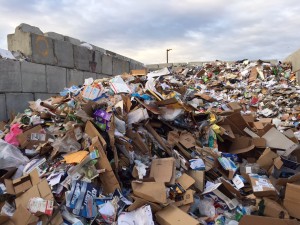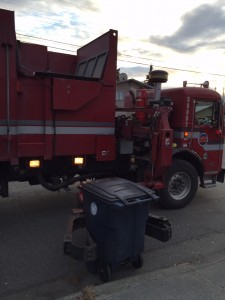
Cans and bottles clink and crash as KSKA’s Anne Hillman dumps her recycling into a bin. The rules about what you can and can’t put in there can be confusing, but they have a reason. So Anne hopped in a recycling truck to sort it out.
A black nine-foot-long arm extends out from the lumbering red truck, and its claw clamps down on a blue recycle bin. The arm hoists the bin into the air, and recyclables tumble into the truck. Empty, the bin is placed back on the ground, and the truck moves on.
Solid Waste Services employee Garret Fairclough guides the maneuver from inside the cab.
“It’s pretty much just one big video game. And that’s what I say, ‘Can you play video games?’ when I train people. Because if you can play video games, you can pretty much do this job.”
Fairclough has been picking up trash and recyclables for about three years. He says it’s simple, but he can talk continuously about the intimate details, like swaying motions of different trucks, the problems of open cans filling with water and ice, the flurried mess of loose grass clippings. He winds his way down a narrow neighborhood alley.

“It’s cool. It’s fun. I love going past schools cause they’re all like ‘Garbage man, honk your horn!'” he says in an awkward falsetto. “And I’m like ‘Alright.'”
In the back of his truck he’s carrying co-mingled recyclables — that’s paper, cans, and plastic bottles. But not all plastics.
“All plastics are not created equal,” says Mary Fisher, executive director of Alaskans for Litter Prevention & Recycling. “Let me just say that first. All plastics are different.”
Fisher says people in Anchorage can only recycle plastic bottles with necks that are marked #1 and #2. And bottles are not the same as plastic containers called clam shells, even if they are marked with the same numbers.
“And that’s because in the plastic world, #1 PET is just the name for the resin that’s used. And then chemicals are added to that resin to form it in certain ways. So a different chemical is used to form a bottle than is a clam shell.”
Which means they melt at different temperatures. Mixing the two reduces the value of the plastic. Fisher says that’s a problem, especially now when the prices for recyclables has been low for about a year.
“The recyclers are very nervous because their profit margins are very, very low right now.”
So they can’t take low value items, like #5 plastics. Fisher says the recycling center in Palmer can take some of them because they are a volunteer-driven non-profit.
Fisher says a couple of inappropriate recyclables mixed in with a bale of ones and twos may not make a huge difference, “but you reach a point very quickly that the contamination really lowers the value of the material.”
So does food contaminate a recycle load? Not really, but Fisher says you should rinse all of your bottles and cans because it’s more sanitary for all of the people who handle them in the sorting process.
And what about plastic caps? First it was no; now it’s yes…
“We have changed because the technology that manages this material has changed, so you can recycle your lids with your plastics.”
Fisher says many of the changes have happened because it makes people more likely to recycle.
“It’s the only industry that I know of that depends on people doing the right thing in their household in order to get the basic material to make the new product. What other industry is there in the world that depends on you doing the right thing?”
Back on the road, Fairclough’s truck is full. He takes the recyclables to the Anchorage Recycling Facility off of Dowling and dumps them in a massive pile.
The truck beeps and rumbles. “So pretty much we use a packer blade to shove it all out,” he explains.
When the area is full, the recyclables are crushed together into square bales, packed into shipping containers and sent off to Seattle. There they’ll be sorted and sold and potentially turned into things that you will recycle later.
Anne Hillman is the healthy communities editor at Alaska Public Media and a host of Hometown, Alaska. Reach her at ahillman@alaskapublic.org. Read more about Anne here.





